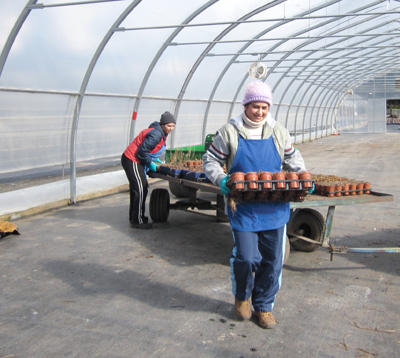
Features
Business
Labour
Special Series Growing Lean #9: Where does safety fit in?
March 27, 2012 By Dale Schattenkirk
According to the Human Resources and Skills Development Canada1
website, one in every 65 employed workers in 2009 was injured or harmed
on the job and received workers’ compensation as a result.
According to the Human Resources and Skills Development Canada1 website, one in every 65 employed workers in 2009 was injured or harmed on the job and received workers’ compensation as a result.
 |
|
| People in the organization should be looking out for one another. Advertisement
|
Of those working in the Agriculture, Hunting, and Forestry category, the rate of injury was 11.5 cases per 1,000 employees or one in every 85 employed workers.
So why did I start this article with these depressing statistics?
Over the past year, I have been telling you stories and writing about Lean and the tools needed to implement this methodology. The question often comes up of why should I do this? What is the benefit?
Safe workplaces do not happen by accident, no pun intended. They are carefully crafted by creating an environment and culture that supports safety.
ENSURING THAT SAFETY IS PART OF WORKPLACE CULTURE
I teach that cultures are created by the processes and systems that are put in place to support the culture the organization wants to have emerge. Safety is everyone’s responsibility – each person in the organization should be looking out for his peers. This is simple to say, but difficult to bring to fruition.
So how does Lean fit in?
When we think of the imbedded principles of the Lean methodology, they are rooted in respect for the employees. Respect is created by empowering and engaging all who work for the organization.
Staff has to feel safe in bringing ideas to the table. This does not mean the typical “suggestion box” or complaint department, but rather a mutually beneficial communication channel.
A typical Lean structure would flow like this:
- The organization creates its strategic and tactical plan including an organizationally accepted vision statement. The vision statement should be a galvanizing component of your organization.
- Improvement ideas, safety issues, customer complaints and compliments would be brought forward and triaged into opportunities that fit the organization’s direction.
- The organization would then put a team together to walk through the DMAIC (Define, Measure, Analyze, Improve and Control) structure to implement sustainable change in the improvement area.
- This cycle would continue as the organization keeps getting better.
LEAN TOOLS CAN HELP REDUCE INJURY POTENTIAL
From a safety standpoint, tools like poka-yoke (mistake-proofing), 5-S, standard work, visual management, and changeover reduction would be keys to reducing the potential for injuries.
Mistake-proofing techniques ensure that staff can get things done right the first time, which reduces rushing things, one of the major causes of workplace injury. Mistake-proofing can also be used to protect staff from harm by implementing things such as guards, barriers, alarms, etc.
Standard work and 5-S help safety by finding the optimal way to do a task and setting up the environment to best accommodate the standard work. The team would look at ergonomics, number of steps taken, and where equipment and supplies are stored, all in an effort to ease the daily repetitive nature of a task.
Changeover reduction would make it substantially easier to switch from one product to the other. This accomplishes several things, among them reduction of hurried work and improved ergonomics for the staff.
All of these tools can be reviewed in past issues of Greenhouse Canada at www.greenhousecanada.com.
As previously mentioned, respect for staff is a foundation of the Lean program. Encouraging staff to not only bring forward concerns but also to genuinely work together to improve the work environment has benefits for everyone. The strongest and most efficient organizations have a safety culture that drives everything, and the Lean “toolbox” can help you get there.
Until next month, keep improving.
1. www4.hrsdc.gc.ca/.3ndic.1t.4r@-eng.jsp?iid=20
Dale Schattenkirk is president/CEO of LTS Consulting, a certified Lean Six Sigma Black Belt, an ISO auditor, and a Certified Human Resources Professional (CHRP). • www.ltsee.com
Print this page